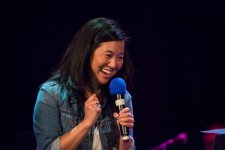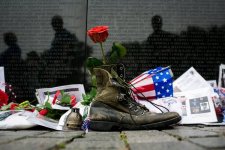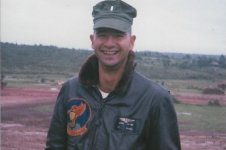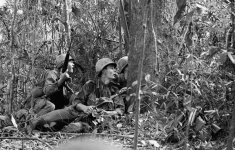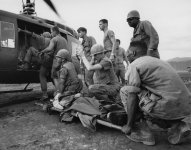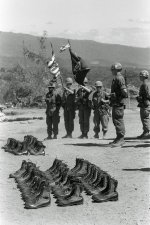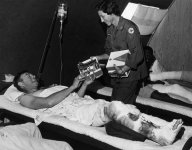jazzeum
Four Star General
- Joined
- Apr 23, 2005
- Messages
- 38,893
"An Encounter in the Central Highlands," by Suzanne Cogan.
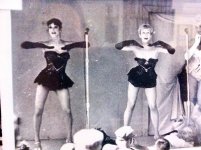
Suzanne Cogan, left, and Sandy Duncan performing at a U.S.O. Show in Vietnam in 1967.
In 1967 I toured Vietnam with the U.S.O. We performed mostly at American bases along the coast that were deemed “secure” by the military. The exception was a visit to an isolated base on a mountaintop in the Central Highlands. When we landed our plane thumped and jittered over huge potholes and uneven terrain, coming to an abrupt stop. Looking out, I spotted the wreckage of similar aircraft.
“This runway is actually too short for this type of plane,” our liaison officer explained. I don’t know if he thought this was reassuring, but I was shaking when I climbed out.
That day we performed two shows on a makeshift platform, the second at twilight. From the stage I could see a tall column of black smoke, curling in the distance.
“What’s that?” I asked one of the soldiers.
“Another plane blew up during takeoff,” he said. “Happens a lot.”
A ripple and turn of heads in the audience. There was a noticeable darkening of mood among soldiers and performers. Those of us in the show ate a somber dinner at the officers club, then went to the noncommissioned officers club to socialize.
I sat in a quiet corner, sipping a Coke. Hanging on the wall, I noticed, was a wood crossbow and quiver made of tree bark. The non-lethal ends of the arrows were fitted with pieces of bamboo.
“Are you admiring the crossbow?” asked a middle-aged staff sergeant.
“I like bows and arrows,” I said. “Ever since I was a kid and fell in love with Robin Hood.”
“Kind of unusual for a girl,” he said. “Mind if I join you?”
“I’d like that,” I said. The guy had a quiet, reflective energy that struck me as unusual in a noncom officer.
“Where are you from?” I asked, the requisite opening question.
“Oklahoma. And you?”
“New York.” I smiled, thinking of home. “How long have you been over here?”
“Several years,” he said. “I re-enlisted. This is my third tour of duty.”
I didn’t know whether to be impressed or to feel sorry for him.
“Do you have a family?” I asked, trying to stick to the suggested subjects.
“Divorced. Two kids. It’s tough on them when you’re away so long. Especially when you’re working in the interior.” He paused. Gave me a quizzical look, as if wondering how much to tell me. I must have passed inspection, since he went on.
“I was a Green Beret,” he said. “I lived with a tribe of Montagnards for several months. That’s what the French called the ethnic non-Vietnamese. That crossbow was given to me by their chief.”
We continued talking for most of the evening. Mostly he spoke about his life in Vietnam, his concern that the Vietcong were more entrenched than ever, that we didn’t seem to be winning the “hearts and minds” of the Vietnamese people. When I looked around, I saw that many of our group had left.
“I should be going soon,” I told him.
“Wait a minute,” he said. “I’d like to show you something.”
He removed the crossbow and quiver from the wall.
“Would you believe this very crossbow shot down a Huey?”
“They shot down a helicopter with that?”
“You bet. It takes two men; one to hold it while the other shoots. They have bigger ones for four men that shoot down full-size choppers. They make everything by hand – bow, quiver, and arrows.” He pulled out a single arrow.
“See this? The tip is dipped in curare” – a type of poison – “in case the enemy is still alive. It’s a highly effective weapon.” He paused, as if weighing the crossbow in his hands.
“Here,” he said, holding it out. “I’d like you to have this.”
“I can’t take it,” I protested. “It was given to you by a Montagnard chief.”
“Yes. As a gift of friendship.”
“But …”
“This is the first time since I’ve been in country that I’ve felt like a human being. Like – someone’s friend. I want you to have it.” He handed me the bow and quiver.
“I don’t know how to thank you.”
“Consider it a gift of friendship, from me to you. And besides …”
“Yes?”
"I don’t know if I’ll make it back. But you will.” He smiled. “Take good care of it. And be careful of the arrows. They might still be poisonous.”
“I’ll be careful,” I said, fighting back tears.
He kissed me lightly on the cheek and left.
I carried the crossbow and arrows throughout Vietnam and onto the plane that brought me home.
I never saw him again; I don’t know what happened to him. But I still have the crossbow. It hangs on my wall.
“This runway is actually too short for this type of plane,” our liaison officer explained. I don’t know if he thought this was reassuring, but I was shaking when I climbed out.
That day we performed two shows on a makeshift platform, the second at twilight. From the stage I could see a tall column of black smoke, curling in the distance.
“What’s that?” I asked one of the soldiers.
“Another plane blew up during takeoff,” he said. “Happens a lot.”
A ripple and turn of heads in the audience. There was a noticeable darkening of mood among soldiers and performers. Those of us in the show ate a somber dinner at the officers club, then went to the noncommissioned officers club to socialize.
I sat in a quiet corner, sipping a Coke. Hanging on the wall, I noticed, was a wood crossbow and quiver made of tree bark. The non-lethal ends of the arrows were fitted with pieces of bamboo.
“Are you admiring the crossbow?” asked a middle-aged staff sergeant.
“I like bows and arrows,” I said. “Ever since I was a kid and fell in love with Robin Hood.”
“Kind of unusual for a girl,” he said. “Mind if I join you?”
“I’d like that,” I said. The guy had a quiet, reflective energy that struck me as unusual in a noncom officer.
“Where are you from?” I asked, the requisite opening question.
“Oklahoma. And you?”
“New York.” I smiled, thinking of home. “How long have you been over here?”
“Several years,” he said. “I re-enlisted. This is my third tour of duty.”
I didn’t know whether to be impressed or to feel sorry for him.
“Do you have a family?” I asked, trying to stick to the suggested subjects.
“Divorced. Two kids. It’s tough on them when you’re away so long. Especially when you’re working in the interior.” He paused. Gave me a quizzical look, as if wondering how much to tell me. I must have passed inspection, since he went on.
“I was a Green Beret,” he said. “I lived with a tribe of Montagnards for several months. That’s what the French called the ethnic non-Vietnamese. That crossbow was given to me by their chief.”
We continued talking for most of the evening. Mostly he spoke about his life in Vietnam, his concern that the Vietcong were more entrenched than ever, that we didn’t seem to be winning the “hearts and minds” of the Vietnamese people. When I looked around, I saw that many of our group had left.
“I should be going soon,” I told him.
“Wait a minute,” he said. “I’d like to show you something.”
He removed the crossbow and quiver from the wall.
“Would you believe this very crossbow shot down a Huey?”
“They shot down a helicopter with that?”
“You bet. It takes two men; one to hold it while the other shoots. They have bigger ones for four men that shoot down full-size choppers. They make everything by hand – bow, quiver, and arrows.” He pulled out a single arrow.
“See this? The tip is dipped in curare” – a type of poison – “in case the enemy is still alive. It’s a highly effective weapon.” He paused, as if weighing the crossbow in his hands.
“Here,” he said, holding it out. “I’d like you to have this.”
“I can’t take it,” I protested. “It was given to you by a Montagnard chief.”
“Yes. As a gift of friendship.”
“But …”
“This is the first time since I’ve been in country that I’ve felt like a human being. Like – someone’s friend. I want you to have it.” He handed me the bow and quiver.
“I don’t know how to thank you.”
“Consider it a gift of friendship, from me to you. And besides …”
“Yes?”
"I don’t know if I’ll make it back. But you will.” He smiled. “Take good care of it. And be careful of the arrows. They might still be poisonous.”
“I’ll be careful,” I said, fighting back tears.
He kissed me lightly on the cheek and left.
I carried the crossbow and arrows throughout Vietnam and onto the plane that brought me home.
I never saw him again; I don’t know what happened to him. But I still have the crossbow. It hangs on my wall.

Suzanne Cogan, left, and Sandy Duncan performing at a U.S.O. Show in Vietnam in 1967.


